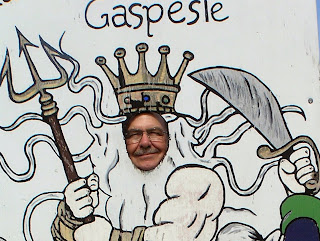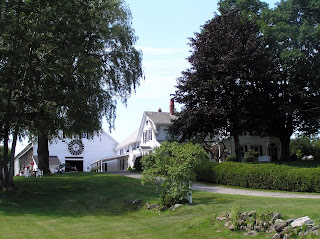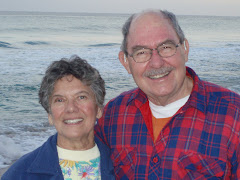




We stayed at Saint Maxine du Mont Louise, the campground mentioned in our next-to last posting, for a couple of days. The RV Park has quite a few sculptures, made from wood and concrete, throughout the park. I have included pictures of two other sculptures which are artistically superior to the miner, although perhaps less novel. The first is of a horse’s head anchored to a large wooden chain. The second is a life-sized wooden statue depicting a worker cleaning a fish – I suppose in honor of the codfish industry,
Madeline spent a lot of time on the beach – first looking, with little success, for shells, and finally collecting sea glass. Much of the glass was of a greenish hue – from old coke bottles, I think, but who knows? It is quite attractive. There was also some white and clear sea glass. A rarer find was brown and blue. The fact that blue was rare is interesting --- indicating I suppose that little cobalt-blue glass is made any more.
A cold front must have moved in on Tuesday night as it grew very cold and terribly windy. We moved west on Wednesday, having a pretty ride down the coast. ( The posting of Aug 27 was on Wednesday evening.)On Thursday we continued our trip. We made one interesting stop at the small city of Rimouski. There were several museums, there --- one of a famous ship-wreck, The Empress of Ireland that went down in 1914, taking over a thousand lives. There was also a lighthouse with a museum in the light housekeeper’s home, and of all things a beached submarine (sous-marin), The Onondaga. When this boat was decommissioned it was purchased for display. After some difficulty, the vessel was eventually brought on to land where it is now a museum. We took a few pictures, but due to time and cost decided to forgo visiting the museum, and continued on.
The trip down the Saint Lawrence was very nice. Every five to seven miles we would come into a small village, with the requisite church, usually a small grocery store, and perhaps a restaurant or two. The style of the houses seems unique to us. Many of the houses are square. A typical house will have a single dormer right in the middle of the front roof. It is not uncommon to see dormers on three or four sides of the houses, Tall rather narrow window are frequently seen in houses, sometimes paired. Most houses have shutters, frequently painted in bright and cheerful colors. The color of the houses is also unique with many houses of bright colors such as red, yellow, green, or even purple, with brightly colored roofs. The homes tend to be freshly painted, and in general seem in better repair, than we are accustomed to see in the US.
There are many farms, -- small, I suppose, by US standards. We see hay out drying, and cows in the field. It seems at times as though we are back to the 1950’s in the US, with many small, active farms. While I am sure they have their share of problems here in Quebec, one does not see the obvious signs of poverty, to which we have become accustomed --- that is no falling-down barns, trailer-homes in poor repair, nor junk cars in the field.
We are now in the small town of Saint-Roch-des Aulnaies, which is on the Saint Lawrence. We will likely stay here for the weekend, and visit Quebec City next week.
Madeline spent a lot of time on the beach – first looking, with little success, for shells, and finally collecting sea glass. Much of the glass was of a greenish hue – from old coke bottles, I think, but who knows? It is quite attractive. There was also some white and clear sea glass. A rarer find was brown and blue. The fact that blue was rare is interesting --- indicating I suppose that little cobalt-blue glass is made any more.
A cold front must have moved in on Tuesday night as it grew very cold and terribly windy. We moved west on Wednesday, having a pretty ride down the coast. ( The posting of Aug 27 was on Wednesday evening.)On Thursday we continued our trip. We made one interesting stop at the small city of Rimouski. There were several museums, there --- one of a famous ship-wreck, The Empress of Ireland that went down in 1914, taking over a thousand lives. There was also a lighthouse with a museum in the light housekeeper’s home, and of all things a beached submarine (sous-marin), The Onondaga. When this boat was decommissioned it was purchased for display. After some difficulty, the vessel was eventually brought on to land where it is now a museum. We took a few pictures, but due to time and cost decided to forgo visiting the museum, and continued on.
The trip down the Saint Lawrence was very nice. Every five to seven miles we would come into a small village, with the requisite church, usually a small grocery store, and perhaps a restaurant or two. The style of the houses seems unique to us. Many of the houses are square. A typical house will have a single dormer right in the middle of the front roof. It is not uncommon to see dormers on three or four sides of the houses, Tall rather narrow window are frequently seen in houses, sometimes paired. Most houses have shutters, frequently painted in bright and cheerful colors. The color of the houses is also unique with many houses of bright colors such as red, yellow, green, or even purple, with brightly colored roofs. The homes tend to be freshly painted, and in general seem in better repair, than we are accustomed to see in the US.
There are many farms, -- small, I suppose, by US standards. We see hay out drying, and cows in the field. It seems at times as though we are back to the 1950’s in the US, with many small, active farms. While I am sure they have their share of problems here in Quebec, one does not see the obvious signs of poverty, to which we have become accustomed --- that is no falling-down barns, trailer-homes in poor repair, nor junk cars in the field.
We are now in the small town of Saint-Roch-des Aulnaies, which is on the Saint Lawrence. We will likely stay here for the weekend, and visit Quebec City next week.






















